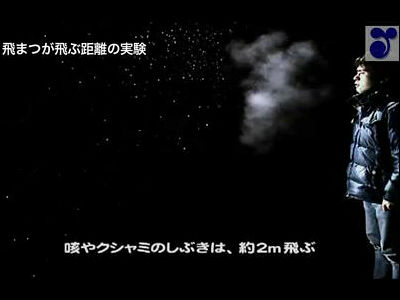Experts suggest that the definition of airborne transmission should be fundamentally reviewed from the new corona

The new coronavirus, which occurred at the end of 2019 and is still rampant around the world in August 2021, is mainly transmitted by droplets (himatsu) that spread by coughing and sneezing. It has been said that infection spreads by inhaling or contacting the surface of contaminated objects. However, the
Airborne transmission of respiratory viruses | Science
https://science.sciencemag.org/content/373/6558/eabd9149
Several pathogens, including the new coronavirus, have been found to diffuse through very small droplets called 'aerosols' that float in the air stream. Droplets and aerosols occur during a variety of exhalation activities, including normal breathing, conversation, and coughing. Advances in technology have made it possible to measure the size of aerosols, and it is known that most of the aerosols contained in exhaled breath are less than 5 μm, and some of them are less than 1 μm for breathing, conversation, and coughing. ..
WHO describes airborne transmission as 'the spread of infectious agents caused by the spread of droplet nuclei that remain infectious when suspended in the air for long distances and long periods of time', but is generally 'from infected persons 1'. It is defined as 'infecting by aspirating infectious aerosols or droplet nuclei of 5 μm or less at a distance of ~ 2 m or more', and so far the difference between droplets and aerosols is 'aerosol if the diameter is 5 μm or less'. It has been distinguished as such. If the diameter of the droplet is larger than 5 μm, it becomes a droplet and is not included in the definition of airborne infection, so it was said that there are very few pathogens that infect air.
However, according to the research team, there is already evidence to support airborne infections such as the new coronavirus, SARS coronavirus , Middle East respiratory syndrome coronavirus , influenza virus, hitrinovirus , and respiratory syncytial virus. The researchers point out that droplet and deposit infections alone cannot explain the 'super spread' seen in the pandemic of the new coronavirus and the difference between indoor and outdoor infections.

The research team renewed the definition of aerosol, 'floating in stationary air from a height of 1.5 m for 5 seconds or more', 'reaching a distance of 1 to 2 m from the releaser', 'maximum particle size It insists that it should be '100 μm'. The movement of aerosols containing viruses is greatly affected by the physicochemical properties of the aerosol itself and environmental factors such as temperature, relative humidity, amount of ultraviolet rays, and airflow, and if the inhaled aerosol is large, it is small up

The graph below shows the size of the aerosol (horizontal axis) and flight time (vertical axis, logarithmic display), and the lines are color-coded according to the height of emission. You can see that the smaller the aerosol size, the longer the flight time. In addition, the flight time of the aerosol released from a height of 1.5 m is 5 seconds when the diameter is 100 μm, 33 minutes when it is 5 μm, and 12 hours or more when it is 1 μm. It is true that droplets can be infected with the new coronavirus, but droplets quickly fall to the ground or the surface of an object within a few seconds, so the droplet infection is only rampant when talking within a distance of 20 cm. The research team argued that it would be possible.

In addition, the fact that ventilation has a great effect on infection, that even if you wear a mask or goggles, you can be infected with the new coronavirus, indoor super spreads, animal experiments, airflow simulation results show that the new coronavirus is The researchers claim that it is clear evidence of an airborne infection.
'Airborne transmission of pathogens has not been well evaluated so far, most of the reason is a lack of understanding of the behavior of aerosols in the air, and some observations have been misunderstood. It was there. ' He insisted that the route of infection by aerosols should be re-evaluated not only for the new coronavirus but also for all respiratory tract infections, and be careful about air filtration, UV disinfection, and wearing masks with ventilation and air purifiers. He said precautions should be taken to mitigate aerosol infections, both short and long distances.
Related Posts:
in Science, Posted by log1i_yk







